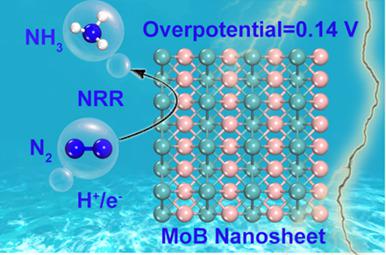当前位置:
X-MOL 学术
›
Int. J. Quantum Chem.
›
论文详情
Our official English website, www.x-mol.net, welcomes your feedback! (Note: you will need to create a separate account there.)
N2 electrochemical reduction on two dimensional transition metal monoborides: A density functional theory study
International Journal of Quantum Chemistry ( IF 2.2 ) Pub Date : 2020-11-21 , DOI: 10.1002/qua.26548 Shaohua Xu 1, 2 , Gangqiang Qin 2 , Quan Jiang 1, 2 , Qianyi Cui 2 , Aijun Du 3 , Chongjun Zhao 1 , Qiao Sun 2
International Journal of Quantum Chemistry ( IF 2.2 ) Pub Date : 2020-11-21 , DOI: 10.1002/qua.26548 Shaohua Xu 1, 2 , Gangqiang Qin 2 , Quan Jiang 1, 2 , Qianyi Cui 2 , Aijun Du 3 , Chongjun Zhao 1 , Qiao Sun 2
Affiliation

|
Electrochemical reduction of N2 at ambient conditions is emerging as a promising route and can be powered by sustainable energies. Large overpotential and the competing hydrogen evolution reaction (HER) are the two major issues associated with the N2 reduction. Thus, the development of efficient electrocatalysts with low overpotential is of utmost significance for electrochemical nitrogen reduction reaction (NRR). In this theoretical study, we report a valuable insight toward a novel two dimensional (2D) transition metal monoboride (TMB) material possessing efficient electrocatalysts application for NRR, investigated by density functional theory method. Through systematically exploring the Gibbs free energy of N2 adsorption on the different TMB (TM = Cr, Mn, Fe, Co, Ni and Mo) nanosheets and analyzing adsorption energy of N2H and NH2 species on these catalysts, we found MoB nanosheets may be the optimum choice as an electrocatalyst for NRR. Moreover, our results also indicate that NRR on MoB nanosheets via the enzymatic pathway is the most favored pathway and *NH*NH → *NH*NH2 is potential‐limiting step with a very low applied overpotential of 0.14 V. In addition, the limiting potentials of NRR (−0.30 V) and HER (−0.48 V) on MoB nanosheet suggest that NRR is prefer to happen on the catalyst. Overall, this study demonstrates that MoB nanosheets as a novel 2D monolayer, which might be utilized as an efficient electrocatalyst for NRR at ambient conditions.
中文翻译:

二维过渡金属单硼化物的N2电化学还原:密度泛函理论研究
N 2的电化学还原在环境条件下正在成为一种有前途的途径,并且可以由可持续能源提供动力。大的超电势和竞争性的放氢反应(HER)是与N 2还原相关的两个主要问题。因此,开发低电势低的高效电催化剂对于电化学氮还原反应(NRR)至关重要。在这项理论研究中,我们报告了一种对新型二维(2D)过渡金属单硼化(TMB)材料的宝贵见解,该材料具有适用于NRR的高效电催化剂,并通过密度泛函理论方法进行了研究。通过系统地探索N 2的吉布斯自由能吸附在不同的TMB(TM = Cr,Mn,Fe,Co,Ni和Mo)纳米片上,并分析N 2 H和NH 2物质在这些催化剂上的吸附能,我们发现MoB纳米片可能是最佳的电催化剂。 NRR。此外,我们的结果还表明,通过酶促途径在MoB纳米片上的NRR是最受青睐的途径,* NH * NH→* NH * NH 2是电势限制步骤,施加的超电势非常低,仅为0.14V 。 MoB纳米片上NRR(-0.30 V)和HER(-0.48 V)的极限电势表明NRR更喜欢在催化剂上发生。总的来说,这项研究表明MoB纳米片是一种新颖的2D单层膜,可在环境条件下用作NRR的有效电催化剂。
更新日期:2020-11-21
中文翻译:

二维过渡金属单硼化物的N2电化学还原:密度泛函理论研究
N 2的电化学还原在环境条件下正在成为一种有前途的途径,并且可以由可持续能源提供动力。大的超电势和竞争性的放氢反应(HER)是与N 2还原相关的两个主要问题。因此,开发低电势低的高效电催化剂对于电化学氮还原反应(NRR)至关重要。在这项理论研究中,我们报告了一种对新型二维(2D)过渡金属单硼化(TMB)材料的宝贵见解,该材料具有适用于NRR的高效电催化剂,并通过密度泛函理论方法进行了研究。通过系统地探索N 2的吉布斯自由能吸附在不同的TMB(TM = Cr,Mn,Fe,Co,Ni和Mo)纳米片上,并分析N 2 H和NH 2物质在这些催化剂上的吸附能,我们发现MoB纳米片可能是最佳的电催化剂。 NRR。此外,我们的结果还表明,通过酶促途径在MoB纳米片上的NRR是最受青睐的途径,* NH * NH→* NH * NH 2是电势限制步骤,施加的超电势非常低,仅为0.14V 。 MoB纳米片上NRR(-0.30 V)和HER(-0.48 V)的极限电势表明NRR更喜欢在催化剂上发生。总的来说,这项研究表明MoB纳米片是一种新颖的2D单层膜,可在环境条件下用作NRR的有效电催化剂。


























 京公网安备 11010802027423号
京公网安备 11010802027423号